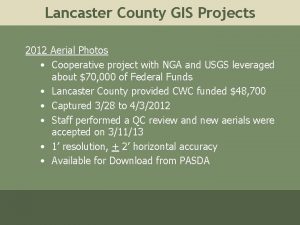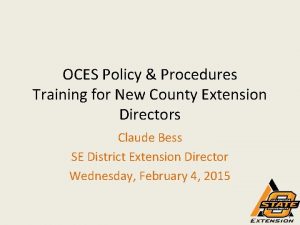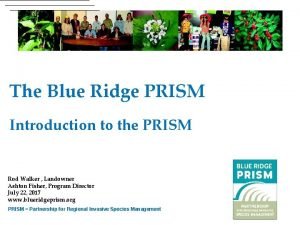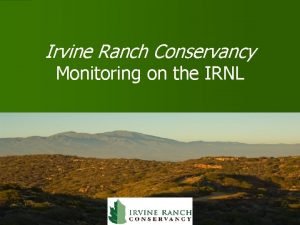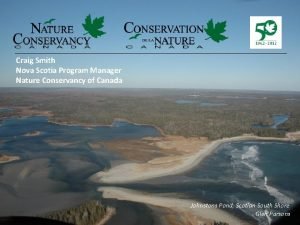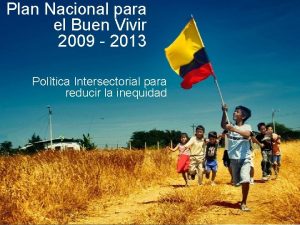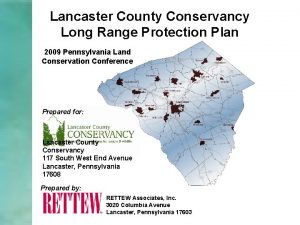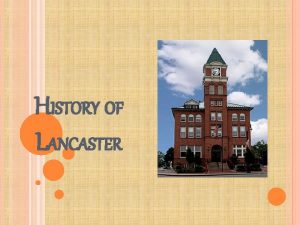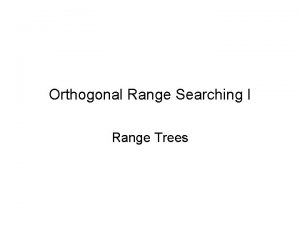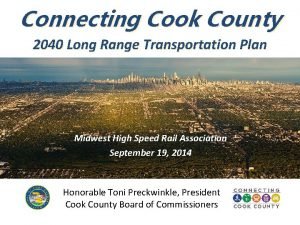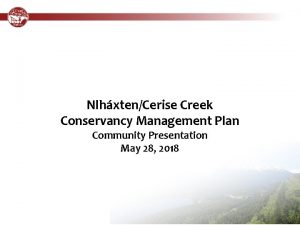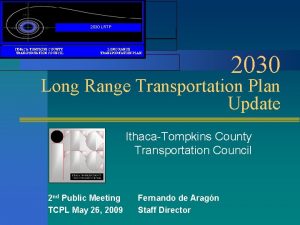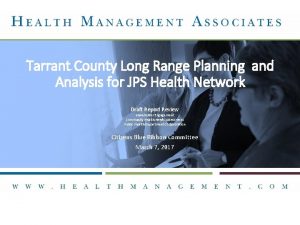Lancaster County Conservancy Long Range Protection Plan 2009





















- Slides: 21

Lancaster County Conservancy Long Range Protection Plan 2009 Pennsylvania Land Conservation Conference Prepared for: Lancaster County Conservancy 117 South West End Avenue Lancaster, Pennsylvania 17608 Prepared by: RETTEW Associates, Inc. 3020 Columbia Avenue Lancaster, Pennsylvania 17603

Project Purpose • To develop a process of how to evaluate what properties are important to the Lancaster County Conservancy for the protection of natural environments.

GOALS • Provide a balance between open space & development • Define & Identify “Natural Gems” • Establish Priority Protection Areas • Identify Potential Green Infrastructure • Initiate a Preservation Partnering Structure with Other Entities • Inform County & Municipal Planning

Lancaster County Growth Boundaries

Landscape Perspective

Parcel Based Perspective

Process Components Partnerin Protectio g n

Partnering Tool (database) • Microsoft Access database to record and track information on parcel basis • Contains information of protected lands by other organizations (i. e. Pennsylvania Game Commission) • Includes protected land targeted lands • Identifies potential partnership opportunities

Partners of the Conservancy Contacted over 100 agencies/organizations Lancaster County Planning Commission PADEP/DCNR/PAFBC/PAGC/USFWS/PHMC Natural Lands Trust / 7 Conservancies 7 Colleges 29 Watershed Organizations 10 Historical Societies Trout Unlimited 60 Municipalities PA Audubon Society Chesapeake Bay Foundation

Development of the Partnering Tool

Process Components Partnerin Protectio n g

Protection Tool (GIS Analysis) • Link to Lancaster Counties GIS Database

Protection Tool • Identifies “Natural Gems” using GIS • Based on 7 environmental attributes of importance to the Conservancy • 65 parcels identified; 12, 133 acres

Defining Natural Gems • Step 1 – Identify Important Attributes & Develop Rating System • Step 2 – Build GIS Datasets and Test • Step 3 – Run GIS Analysis and Obtain Scores • Step 4 – Run QA/QC Data • Step 5 – Analyze GIS Output and Determine “Gem” Cut Off • Step 6 – Run Final Analysis

Natural Gem Rating Attribute Unique 7 Points Above Average 5 points Average 3 points Below Average 1 point N/A O Points Water bodies Rated “Exceptional Value” and/or wild trout waters Rated “High Quality” and/or stocked trout waters and/or wild bass waters Simply rated as warm or coldwater fishery Impaired – trumps HQ No water resources Wetlands with PNDI hits NA Common wetland community NA No wetland present Forestland ≤ 200 acres 50 – 199 acres 20 – 49 acres 1 – 19 acres 0 – 0. 99 acres Grassland with PNDI hit NA Common plant community/grassland NA No grasslands present Geologic Features Rare, fossil beds, caves, cliff community NA NA NA Nothing to observe Plants Greater than 3 species of state listed concern 1 or 2 species of state listed concern Common plant community NA No plant community or species of concern Animal (insects, amphibians, reptiles, mammals, fish and birds) Greater than 2 species of state listed concern and/or specialized habitat elements such as rookery or cave 1 species of state listed concern and/or highly diverse habitat supporting diverse animal community Semi-diverse habitat supporting common animal species – no rare, threatened or endangered species NA No habitat or species of concern Adjacent to other preserved tracts Adjacent to other Conservancy tracts Adjacent to State lands such as Gamelands – Co. Parks All other semi-private preserves NA Not adjacent to other preserved tracts

Example of Cocalico Creek Watershed

Priority Protection Focus Areas • “Smoothed” data to define large, contiguous regions, or clusters • Clusters must have a score of 20 or higher for majority of area • Must have an area of at least 15 square miles • 10 areas were identified

Priority Protection Focus Areas

Furnace Run Focus Area Close-up

Implementation & Successes • Ground Truthing • Conservancy Needs to Determine Implementation Strategy • Natural Heritage Inventory data update • Weighting Development and Analysis • Grant Infrastructure Plan Development • Threat of Loss Analysis • Partnering with: County/TNC/Municipalities/Others

Who will use data/tool? • Can be used by multiple users by changing attributes or importance of attributes • Similar tool could be developed for watershed groups, county planning commissions, and the State
 As compared to long-range forecasts, short-range forecasts
As compared to long-range forecasts, short-range forecasts Lancaster county gis
Lancaster county gis Lancaster county extension
Lancaster county extension Short short short long long long short short short
Short short short long long long short short short Once upon a time there was a poor girl
Once upon a time there was a poor girl Conservancy system
Conservancy system Ocean conservancy internship
Ocean conservancy internship Difference between conservancy and water carriage system
Difference between conservancy and water carriage system The nature conservancy
The nature conservancy Difference between conservancy and water carriage system
Difference between conservancy and water carriage system Irnl
Irnl Nature conservancy of canada nova scotia
Nature conservancy of canada nova scotia Short term planning and long term planning
Short term planning and long term planning Plan nacional del buen vivir 2009 al 2013
Plan nacional del buen vivir 2009 al 2013 Augustus waters death
Augustus waters death Lancaster 2004
Lancaster 2004 Frederick wilfrid lancaster
Frederick wilfrid lancaster Agresso lancaster
Agresso lancaster Pnedr
Pnedr Lancaster autor
Lancaster autor Patricia lancaster
Patricia lancaster Lancaster pedagogo
Lancaster pedagogo

